Don't wanna be here? Send us removal request.
Text

OPERATION CORPORATE :Air-to-air refueling in the Falklands/Malvinas War
Fernando Valduga By Fernando Valduga 06/12/2022 - 20:45 in History, Military, War Zones
Replenishment from Victor to Victor. Twenty-two of these meetings were required for each Black Buck mission from the Island of Ascension to the Falklands and return.
On April 2, 1982, Argentine forces invaded the capital of the Falkland Islands, Stanley, and quickly defeated a small British garrison. They then took control of the island of South Georgia. By the end of the month, 10,000 Argentine soldiers were stationed in the Falklands/Malvinas. They were mainly poorly trained and equipped recruits. England urgently needed to move its forces to the islands.
The next day, Prime Minister Margaret Thatcher told the House of Commons - in a very rare Saturday session - that "it is the Government's goal that the islands are freed from occupation and returned to the British administration as soon as possible".

The functions assigned to the RAF for Operation Corporate were reconnaissance, ground attack, transport of personnel and cargo, as well as the aeromedical evacuation of the injured during the conflict. The RAF also showed the psychological exercise of the demonstration of will and ability.
But although these tasks were clear, the resources to deliver them were much smaller. The distances were vast. Even from the advanced base at Wideawake Airfield on Ascension Island, there was no aircraft that could fly to the Falklands and return without support; tankers were vital and, of course, any aircraft that went so far had to be able to receive fuel from a tanker.
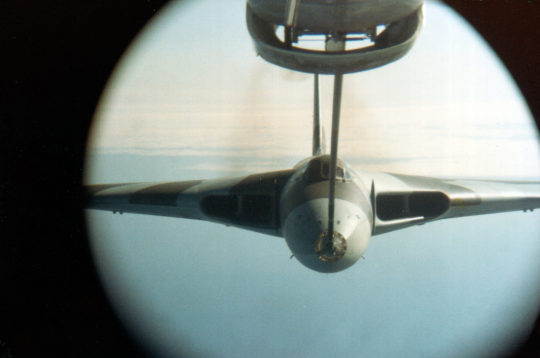
The view through the rear periscope of a Victor tanker while refueling a Vulcan bomber over the South Atlantic.
This limited the choice to Avro Vulcan. However, an increasingly smaller number of these Vulcans remained: only those who escaped retirement in museums or the torch. Some Vulcans were already on display in museums.
The unknown hero: the handley Page Victor refueler
As for the tankers, there were a few dozen Handley Page Victor K2, with the main task of supporting the English Electric Lightnings Rapid Reaction Force, defending Britain's Air Defense Identification Zone, mainly against Soviet aircraft that skirted the North Cape in the North Atlantic. The VC10 refuelers were not yet in service.
Quite simply, without the Victor tankers, Operation Corporate could not have been launched.
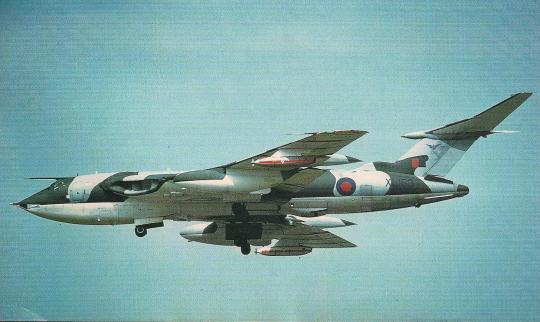
Victor as a V-bomber
Victor began his career in the 1950s as a strategic bomber, entering the service of the Bomber Command in April 1958. Together with his mission companions, the Vickers Valiant and the Avro Vulcan, his main objective was to transport the British atomic bomb 'Blue Danube' (weighing 10,000 lb / 4.5 tons) to Moscow. The previous generation of RAF bombers - Handley Page Halifax, Avro Lancaster/Lincoln and Boeing B-29 Washington, which the three V-Bombers were replacing, flew lower, were slower and equipped with weapons for self-defense, while the 1946 Operational Requirement against which both Victor and Vulcan were designed followed the same principle They should fly higher and faster to overcome the opposition: 500 mph (800 km/h) at 50,000 feet (15,000 meters). No Soviet fighter or anti-aircraft weapon could threaten them. Later, the Victors reached 620 mph (1,000 km/h) at 62,000 feet (19,000 meters).

But this invincibility would not last long. On May 1, 1960, a Lockheed U-2 reconnaissance aircraft piloted by Frances Gary Powers, borrowed from the United States Air Force to the Central Intelligence Agency, was shot down while flying over Sverdlovsk Oblast in the Ural Mountains of the USSR. Soviet air defense technology had reached altitude quickly. The Soviet missile S-75 Dvina (NATO SA-2 report name 'Guideline') could probably reach 70,000 feet. Right above the ceiling of the Victors and Vulcans. The V-Bombers were no longer safe at altitude.

The RAF V-Bombers: Valiant, Victor and Vulcan.
In early 1963, the Air Council recognized that improved Soviet air defenses meant that the V-Bombers could no longer expect to survive at a high level, so it introduced the need for low-level attacks: instead of flying at 50,000 feet, they would fly very low - 100 feet - in heavily defended areas of the Soviet Union.
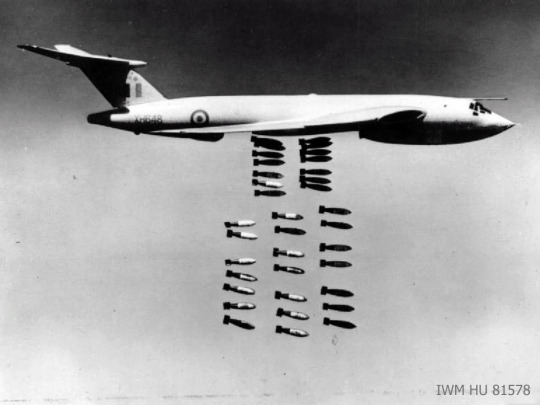
But the Victors were not able to fly at low altitude, where their most delicate wings could not withstand the tensions of the greatest turbulence.
What to do with all of them? Convert them into tankers.
The need for tanker planes
The early 1960s saw the introduction of English Electric Lightning into the Fighter Command (before becoming the Attack Command). Incredibly fast with twice the speed of sound, I was also desperately thirsty. The refuelers were vital to allow the Rapid Reaction Alert Lightnings to scare away the Soviet Tupolev Tu-95 'Bear'.
In 1965, with the sudden withdrawal from service of all Valiants due to wing fatigue caused by low-level air turbulence, the first Victors were converted into tank planes. Some Victors had two hoses and could still carry bombs, while others, later all, were three-point. The latter had one on each wing and a larger Hose Drum Unit (HDU) in the bomb compartment, thus losing its bombing capacity. Wing hoses were only suitable for lighter, hunting-style aircraft, while bombers and heavier transport aircraft had to use the axis hose for aerodynamic reasons.
The first Victors were launched for tank conversion, as the most powerful B2 variants began to be delivered in 1962, but in due course 24 of these B2s were converted into K2 tankers.

Although by Operation Corporate all Victors were converted into tank planes, a retro modified Victor carried out one of the first offensive operations flying a radar and visual reconnaissance mission to South Georgia.
During the combat phase of Operation Corporate, all aircraft going from Ascension to the south to the Falklands and fighters coming from the United Kingdom to Ascension required several tankers.
At the receiving end
The following individual types participated in Operation Corporate and benefited from air-to-air refueling to fulfill their missions:
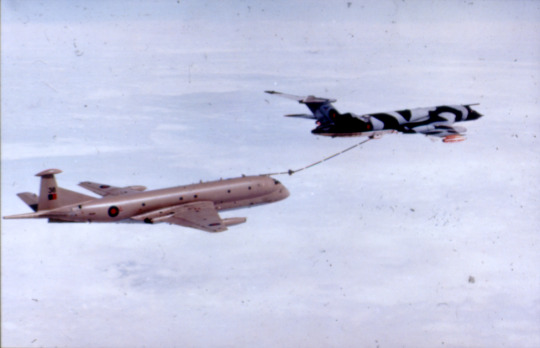
Hawker Siddeley Nimrod MR2
Nimrod carried out reconnaissance missions and provided navigation and search and rescue coverage to Harriers on their flights over the water from Ascension Island to the Task Force and also for Black Buck missions with the Vulcans. It also provided communications with nuclear attack submarines going "to the south".
These Nimrods had to have refueling systems installed for the first time for Operation Corporate, then on April 13, 1982 (only 11 days after the invasion), the Ministry of Defense made a request to Flight Refueling Ltd to install refueling equipment. The first test flight took place on April 30. The Nimrods were not designed for this, nor were there spare parts in stocks. Just like the Vulcans, museums and scrap depots were searched for pieces. Perhaps unbelievably, the Vulcan recently presented to Castle Air Base, California, was invaded by RAF engineering noncommissioned officers in civilian clothing to get the plumbing parts. After the conflict, Castle Air Base congratulated the RAF for this spectacular audacity. And he demanded that the pieces be returned.
With in-flight refueling, a Nimrod remained on patrol for 19 hours.
Tragically, however, the addition of in-flight refueling plumbing was a factor in the loss of the Nimrod "XV 230" over Afghanistan 24 years later: a fuel leak from the refueling causing a catastrophic fire and the death of all 14 military personnel on board.
Hawker Harrier GR3
The RAF frontline attack capabilities with combat capability in 1982 were limited to the McDonnell Douglas F-4 Phantom, Blackburn Buccaneer and Hawker Siddeley Harrier GR 3 jets. All three had air-to-air refueling capacity. But it would not be reasonable to expect a pilot to fly 8,000 miles in 16 hours - even if he had the ability to navigate, which he did not have. Even the aircraft didn't have enough oil for its engines at these distances. The only one of these three that was used was the Harrier GR3.
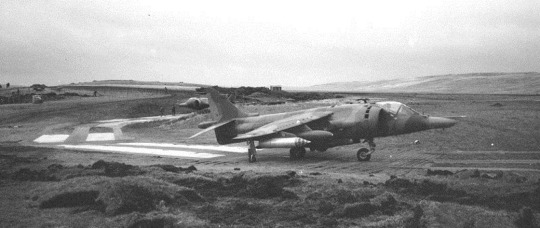
The RAF Harriers were initially assigned to Operation Corporate as friction substitutes for any Sea Harriers lost in combat. However, the losses were fortunately lower than expected. However, the integration of these aircraft with an aircraft carrier was far from simple, as about 30 modifications were required. Its inertial navigation systems are designed to be calibrated in a known fixed location, but of course an aircraft carrier never stands still. In fact, this mating with the aircraft carrier was never achieved, so GR3 pilots relied on a ruler, pencil and a 'Mk 1 eyeball' to aim at the bomb.
The engines didn't have the corrosion-resistant special coatings that the Sea Harriers had to combat the damage caused ?? by the air loaded with salt. Magnesium components (aluminum in Sea Harriers) reacted chemically to salt water. Naval transponders had to be installed, holes were drilled to allow water drainage, additional mooring points to handle the rolling and throwing of aircraft carriers in rough seas and the nose steering mechanism modified. However, despite all these modifications, a GR3 could never have been a direct replacement for a Sea Harrier as a fighter. Although the AIM-9L Sidewinders air-to-air missiles were installed, the Harrier had no radar.
Some flew from England to the Task Force, stopping at Yandun International Airport, Banjul (Gambia) and Wideawake Airfield on Ascension Island. They used large-sized fuel tanks and REVO probes, but records suggest that they did not fit the tips of the extension wings designed only for these transfer flights; a batch flew nonstop from St Mawgan to Ascension and, a few days later, straight to the Task Force, making their first landing on the deck of aircraft carriers in the middle of an air alert.
Lockheed Hercules
The workhorse of the transport fleet. In addition to lifting UK personnel and cargo for Ascension, they supported the Task Force flying south and uncharged skydiving equipment before leaving the UK and key personnel, including, it is said, special forces.
Marshalls of Cambridge Ltd installed refueling probes on 16 Hercules aircraft, allowing them to fly from Ascension to Stanley and return; flight lieutenant T Locke broke the record for resistance flying for 28 hours and 4 minutes to launch electrical components and missiles into a Rapier missile battery positioned around Port Stanley.
Avro Vulcan B2
At the end of their operational lives, the Vulcan were called upon to carry out what was then the longest bombings in the world - the almost 6,400 km of Wideawake Airfield, Ascension Island, Port Stanley, Falkland/Malvinas Islands, a 16-hour round trip - in the famous "Black Buck" attacks; it took 13 Victor tankers to place a Vulcan on the target, with 15 air-to-air refuelings (AAR) between the only Vulcan and between Victors (some of the latter flying two missions that night).
The Vulcans did not need the support of tankers for their European nuclear role, so most of the plumbing was removed and had to be replaced by spare parts and pieces found in museums and junkyards. And the current pilots had not been trained in air refueling, so a sixth crew member was added - an aircraft captain Victor qualified as an air-to-air refueling instructor.
The Vulcans in particular on the Black Buck missions were from a batch of Mark B2s that had several modifications in order to transport the Skybolt missile (intended to replace Blue Steel, but discarded). They had more powerful Olympus 301 engines, compared to the Olympus 201 of the other B2s. And since Skybolt had celestial navigation - it also had to see the stars - they had to be mounted on pillars under the wings, as well as the reinforcement and wiring left over from this intended function, now allowing ECM (electronic countermeasures) and Shrike anti-radiation missiles (radar).
Although the damage to Stanley Airport in the first of Operation Black Buck's attacks was modest (a 1,000-pound bomb on the runway), the psychological impact was profound. If a Vulcan could reach Stanley, it could also reach the continent. Thus, the powerful Mirage fighter jets that escorted the attacks on the Task Force were stopped to protect the country of origin.
Hawker Sea Harrier FRS 1
Colloquially called 'Shars', the Sea Harriers were assets of the Royal Naval Air Service, and benefited from the support of RAF (Victor) tankers and Nimrod air rescue aircraft on transfer flights.
The aircraft on board the ships HM 'Invincible' and 'Hermes' did not need support from tankers, but Squadron No. 809 flew from RNAS Culdrose to Ascension, with the assistance of tankers; a night stop was made at Yandun International Airport, Banjul, Gambia, then to Ascension. Large transfer fuel tanks with a capacity of 330 gallons (1,500 liters) were available for each internal pestle, but tests on the ski jump of the Royal Naval Air Station Yeovilton showed that they negatively affected the finish and stability, so that the standard 100-gallon (450 liters) combat tanks were used. Again, there is no evidence that the larger "translate wing tips", which added support, were installed.
But the flight was not without problems: a SHAR losing its oxygen system, having to fly at a much lower altitude, with higher fuel consumption; another SHAR and his handlebar Victor losing navigation systems so that all the formation depended on a man in their SHAR for routing; and a Victor being unable to deploy the hoses mounted on the wings, so the SHARs had But as a SHAR pilot said 'what the hell, this is war'.
Consequences
Argentine forces surrendered on June 14, 1982. However, the problem of the continuous protection of the Falklands/Malvinas Islands and their population from a renewed Argentine invasion, if the United Kingdom armed forces withdrew, has now come to light and, therefore, a significant military capacity had to remain in place, far beyond the nominal strength of the Royal Marines who had been the permanent garrison before the invasion. A very significant logistical and defense challenge.
From the RAF's point of view, this initially meant establishing a large air bridge.
Were the Victors being used ?? at a very unforeseen rate, consuming their lives of fatigue. Then, two somewhat drastic measures were necessary until the first VC10 tankers entered service: convert Vulcans and Hercules into tankers.
Part of the British aircraft that played an important role in England's victory in the war.
With the Vulcans, two additional fuel tanks were installed in the cavernous pump compartment and the HDU was inserted where the ECM equipment was in compartments in the tail, behind the rudder. The only basket was housed in a metal and wooden box below the back of the tail. An order was placed with British Aerospace in Woodford on May 4 and only 50 days later, June 23, the XH 561 was delivered to Waddington RAF Base; it carried out tests on the same day delivering fuel to another Vulcan and a Victor.
Hercules Refillers
As for Hercules, one solution - of the Heath-Robinson type - was the contract given to the Marshalls of Cambridge to convert 4 Hercules to play the role of tank planes, one of which would be based on Stanley and Ascension.
It is true that the U.S. Marine Corps has been using the KC-130 tankers since the early 1960s, but these were designed for the task, with additional poles for the external hoses of the external engines and the appropriate wiring and plumbing. But the RAF Hercules did not have this, so the solution adopted by the Marshalls was much faster and more brutal: adding tanks to the cargo area; putting an HDU in the cargo door; and drilling a hole in the door for the hose.
‘Toboggan’
Air-to-air refueling is a delicate and dangerous operation, where errors lead to fatalities. Two large aircraft need to fly at exactly the same speed and maintain the same positions relative to only tens of meters away - even at night and in severe turbulence.
The first propeller tanker refueled combat planes that were faster than them. Jet tankers - such as Victor - solved this problem, but Operation Corporate receivers and Hercules produced the same problem on the contrary: Victor tankers were too fast for Hercules receivers.
The solution was a technique known as a toboggan: the two aircraft climbed separately to altitude and then dived, gaining speed. This would allow Hercules to pick up and connect with Victor's basket. At a lower altitude, they separated, went up and repeated - several times, if necessary.
Continued service
The Victors continued to serve until Operation Granby, the First Gulf War in 1991, and was withdrawn to RAF service in October 1993.
But the last flight (to date) of a Victor was on August 25, 2009, during a high-speed taxi run by a museum piece that got out of control when Victor took command and tried to fly...
Tags: Military AviationFalklands/Malvinas WarHandley Page VictorHistoryRAF - Royal Air Force/Royal Air ForceREVO - Air RefuelingWar Zones - South Atlantic
Fernando Valduga
Aviation photographer and pilot since 1992, he has participated in several events and air operations, such as Cruzex, AirVenture, Dayton Airshow and FIDAE. He has works published in a specialized aviation magazine in Brazil and abroad. He uses Canon equipment during his photographic work in the world of aviation
HOME Main Page Editorials Information Events Collaborate SPECIALS Advertise About
Cavok Brasil - Digital Tchê Web Creation
Commercial
Executive
Helicopters
History
Military
Brazilian Air Force
Space
SPECIALS
Cavok Brasil - Digital Tchê Web Creation
99 notes
·
View notes
Text
887 notes
·
View notes
Text
20K notes
·
View notes
Text
6K notes
·
View notes
Video
16K notes
·
View notes
Text
Les noeuds qu'il faut impérativement savoir
November 12 2021
10K notes
·
View notes
Photo

In 2011, an Australian bartender found an ATM glitch that allowed him to withdraw way beyond his account balance. In a bender that lasted some five months, he spent around $1.6 million of the bank’s money. He threw lavish parties, chartered private jets, and paid off his friends’ university fees. Later, he felt guilt and turned himself to the police.
144 notes
·
View notes
Text
Advice from an 80 year old man
1. Have a firm handshake. 2. Look people in the eye. 3. Sing in the shower. 4. Own a great stereo system. 5. If in a fight, hit first and hit hard. 6. Keep secrets. 7. Never give up on anybody. Miracles happen everyday. 8. Always accept an outstretched hand. 9. Be brave. Even if you’re not, pretend to be. No one can tell the difference. 10. Whistle. 11. Avoid sarcastic remarks. 12. Choose your life’s mate carefully. From this one decision will come 90 per cent of all your happiness or misery. 13. Make it a habit to do nice things for people who will never find out. 14. Lend only those books you never care to see again. 15. Never deprive someone of hope; it might be all that they have. 16. When playing games with children, let them win. 17. Give people a second chance, but not a third. 18. Be romantic. 19. Become the most positive and enthusiastic person you know. 20. Loosen up. Relax. Except for rare life-and-death matters, nothing is as important as it first seems. 21. Don’t allow the phone to interrupt important moments. It’s there for our convenience, not the caller’s. 22. Be a good loser. 23. Be a good winner. 24. Think twice before burdening a friend with a secret. 25. When someone hugs you, let them be the first to let go. 26. Be modest. A lot was accomplished before you were born. 27. Keep it simple. 28. Beware of the person who has nothing to lose. 29. Don’t burn bridges. You’ll be surprised how many times you have to cross the same river. 30. Live your life so that your epitaph could read, No Regrets 31. Be bold and courageous. When you look back on life, you’ll regret the things you didn’t do more than the ones you did. 32. Never waste an opportunity to tell someone you love them. 33. Remember no one makes it alone. Have a grateful heart and be quick to acknowledge those who helped you. 34. Take charge of your attitude. Don’t let someone else choose it for you. 35. Visit friends and relatives when they are in hospital; you need only stay a few minutes. 36. Begin each day with some of your favourite music. 37. Once in a while, take the scenic route. 38. Send a lot of Valentine cards. Sign them, ‘Someone who thinks you’re terrific.’ 39. Answer the phone with enthusiasm and energy in your voice. 40. Keep a note pad and pencil on your bed-side table. Million-dollar ideas sometimes strike at 3 a.m. 41. Show respect for everyone who works for a living, regardless of how trivial their job. 42. Send your loved ones flowers. Think of a reason later. 43. Make someone’s day by paying the toll for the person in the car behind you. 44. Become someone’s hero. 45. Marry only for love. 46. Count your blessings. 47. Compliment the meal when you’re a guest in someone’s home. 48. Wave at the children on a school bus. 49. Remember that 80 per cent of the success in any job is based on your ability to deal with people. 50. Don’t expect life to be fair
28K notes
·
View notes
Photo

Bruce Lee - Long Beach International Karate Championships (1964)
6K notes
·
View notes
Text

Tony Benn's speech in the house of commons in 1998.
20K notes
·
View notes
Text
429 notes
·
View notes
Text
307 notes
·
View notes
Photo

Pripyat is probably the most famous ghost town in Ukraine. But according to Wikipedia, there are 62 villages completely abandoned and depopulated. So this map might be useful if you want some real social distancing.
by @jaroslav_sm
430 notes
·
View notes
Text
No need to offload. We'll sit here and rust together

1K notes
·
View notes
Photo

The Enterprise E “Star Trek - The Next Generation”
364 notes
·
View notes

